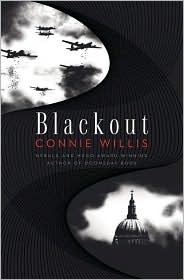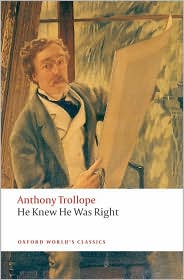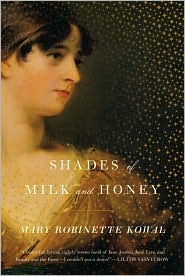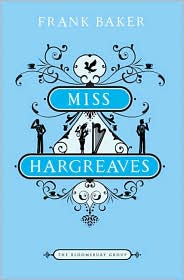These are a few of my favorite 'first' lines read in October 2010.
Some things start before other things.
In the beginning there were nine of us. We left when we were young, almost too young to remember. Almost.
It was a pleasure to burn.
I've watched through his eyes, I've listened through his ears, and I tell you he's the one. Or at least as close as we're going to get.
Ask Paris if a phone call can be deadly. She'll tell you. She learned the truth of it last night.
October's Top Five Ten:
They Called Themselves the K.K.K: The Birth of an American Terrorist Group. Susan Campbell Bartoletti.
The Wee Free Men. Terry Pratchett.
Wintersmith. Terry Pratchett.
The Amazing Maurice and His Educated Rodents. Terry Pratchett.
Doomsday Book. Connie Willis.
The Odyssey. Gareth Hinds.
One Crazy Summer. Rita Williams-Garcia.
Touch Blue. Cynthia Lord.
Fahrenheit 451. Ray Bradbury.
Shipwreck at the Bottom of the World: The Extraordinary True Story of Shackleton and the Endurance. Jennifer Armstrong.
Number of Board Books: 2
ABC, Baby Me! Susan B. Katz. Illustrated by Alicia Padron. 2010. September 2010. Random House. 28 pages.
Baby Baby Baby! by Marilyn Janovitz. 2010. October 2010. Sourcebooks. 24 pages.
Number of Picture Books: 16
Ninja Cowboy Bear Presents The Way of the Ninja. David Bruins. Illustrated by Hilary Leung. 2010. September 2010. Kids Can Press. 32 pages.
Tuck Me In. Dean Hacohen and Sherry Scharschmidt. 2010. Candlewick Press. 40 pages.
Cat the Cat, Who Is That? Mo Willems. 2010. HarperCollins. 24 pages.
Knuffle Bunny Free: An Unexpected Diversion. Mo Willems. 2010. September 2010. HarperCollins. 52 pages.
Naked Mole Rat Gets Dressed. Mo Willems. 2009. Hyperion. 40 pages.
Goodnight Goon. Michael Rex. 2008. Penguin. 32 pages.
The Runaway Mummy: A Petrifying Parody. Michael Rex. 2009. Penguin. 32 pages.
Furious George Goes Bananas: A Primate Parody. Michael Rex. 2010. May 2010. Penguin. 32 pages.
The Adventures of Granny Clearwater & Little Critter. Kimberly Willis Holt. Illustrated by Laura Huliska-Beith. 2010. October 2010. Henry Holt. 32 pages.
My Mommy Hung the Moon. Jamie Lee Curtis. Illustrated by Laura Cornell. 2010. September 2010. HarperCollins. 40 pages.
The Gobble Gobble Moooooo Tractor Book. Jez Alborough. 2010. September 2010. Kane/Miller. 32 pages.
Mad at Mommy. Komako Sakai. 2010. October 2010. Scholastic. 40 pages.
Miles to Go. Jamie Harper. 2010. Candlewick Press. 32 pages.
How To Raise a Dinosaur. Natasha Wing. Illustrated by Pablo Bernasconi. 2010. October 2010. Running Press. 24 pages.
Spork. Kyo Iona Maclear. Illustrated by Isabelle Arsenault. 2010. Kids Can Press. 32 pages.
Babyberry Pie. Heather Vogel Frederick. Illustrated by Amy Schwartz. 2010. October 2010. Houghton Mifflin Harcourt. 40 pages.
Number of Children's Books: 2
We Are In A Book! Elephant and Piggie Series. Mo Willems. 2010. September 2010. Hyperion. 64 pages.
I Will Surprise My Friend: An Elephant and Piggie Book. Mo Willems. 2008. Hyperion. 64 pages.
Number of Middle Grade: 4
Touch Blue. Cynthia Lord. 2010. August 2010. Scholastic. 192 pages.
One Crazy Summer. Rita Williams-Garcia. 2010. [January 2010] HarperCollins. 218 pages.
Ballet Shoes. Noel Streatfeild. 1937. Random House. 256 pages.
The Memory Bank. Carolyn Coman. Illustrations by Rob Shepperson. 2010. October 2010. Scholastic. 288 pages.
Number of YA: 12
The Wee Free Men. Terry Pratchett. 2003. HarperCollins. 400 pages.
I Am Number Four. Pittacus Lore. 2010. August 2010. HarperCollins. 440 pages.
The Lighter Side of Life and Death. C.K. Kelly Martin. 2010. May 2010. Random House. 240 pages.
Dark Sons. Nikki Grimes. 2005. Hyperion. 218 pages.
Inside Out. Maria V. Snyder. 2010. April 2010. Harlequin Teen. 320 pages.
Restoring Harmony. Joelle Anthony. 2010. May 2010. Penguin. 320 pages.
A Hat Full of Sky. Terry Pratchett. 2004. HarperCollins. 288 pages
The Maze Runner. James Dashner. 2009. Random House. 384 pages.
Wintersmith. Terry Pratchett. 2006. HarperCollins. 325 pages.
Behemoth. Scott Westerfeld. 2010. October 2010. Simon & Schuster. 485 pages.
The Amazing Maurice and His Educated Rodents. Terry Pratchett. 2001. HarperCollins. 242 pages.
Lockdown. Walter Dean Myers. 2010. HarperCollins. 247 pages.
Number of Adult: 7
Evil Genius. Wilkie Collins. 1886. 348 pages.
Sweetness at the Bottom of the Pie. Alan Bradley. 2009. Random House. 304 pages.
Elizabeth, Captive Princess: Two Sisters, One Throne. Margaret Irwin. 2010. Sourcebooks. 352 pages.
We Have Always Lived in the Castle. Shirley Jackson. 1962. Penguin. 214 pages.
Fahrenheit 451. Ray Bradbury. 1953. 179 pages.
Doomsday Book. Connie Willis. 1992. Random House. 592 pages.
Frankenstein's Monster. Susan Heyboer O'Keefe. 2010. October 2010. Crown Publishing. 352 pages.
Number of Christian: 10
God's Mighty Acts in Salvation. Starr Meade. 2010. August 2010. Crossway. 87 pages.
The Road to Paris. Nikki Grimes. 2006. Penguin. 160 pages.
I Will Rejoice. Karma Wilson. Illustrated by Amy June Bates. 2007. Zondervan. 32 pages.
Mortimer's Christmas Manger. Karma Wilson. Illustrated by Jane Chapman. Simon & Schuster. 40 pages.
Embers of Love (Striking a Match #1) Tracie Peterson. Bethany House. 352 pages.
The Evangelicals: What They Believe, Where They Are, And Their Politics. Christopher Catherwood. 2010. August 2010. Crossway. 168 pages.
While We're Far Apart. Lynn Austin. 2010. October 2010. Bethany House. 416 pages.
Snow Day. Billy Coffey. 2010. October 2010. FaithWords. 195 pages.
Cottonwood Whispers. Jennifer Erin Valent. 2009. Tyndale. 352 pages.
The First Christmas: A Changing-Picture Book. Illustrated by Sophy Williams. 2010. Candlewick. 14 pages.
Number of Nonfiction: 4
They Called Themselves the K.K.K: The Birth of an American Terrorist Group. Susan Campbell Bartoletti. 2010. August 2010. Houghton Mifflin Harcourt. 172 pages.
Shipwreck at the Bottom of the World: The Extraordinary True Story of Shackleton and the Endurance. Jennifer Armstrong. 1998. Random House. 144 pages.
Just One Bite: 11 Animals and their Bites at Life Size! Lola M. Schaefer. Illustrated by Geoff Waring. 2010. September 2010. Chronicle Books. 40 pages.
The Life of Rice: From Seedling to Supper. Richard Sobol. 2010. Candlewick. 40 pages.
Number of Graphic Novels: 12
Ender's Game: Battle School. (Graphic Novel) Orson Scott Card. Pasqual Ferry. Christopher Yost. 2009. Marvel. 128 pages.
Ray Bradbury's Fahrenheit 451: The Authorized Adaptation. Ray Bradbury. Illustrated by Tim Hamilton. 2009. July 2009. FSG. 160 pages.
The Odyssey. Gareth Hinds. 2010. October 2010. 256 pages.
Binky to the Rescue. Ashley Spires. 2010. Kids Can Press. 64 pages.
Beowulf. Gareth Hinds. 2007. Candlewick Press. 128 pages
The Muppet Show Comic Book: Meet the Muppets. Roger Langridge. 2009. Boom. 112 pages.
Muppet Robin Hood. Tim Beedle. 2009. Boom. 112 pages.
Muppet Peter Pan. Grace Randolph. 2010. Boom. 112 pages.
Muppet King Arthur. Paul Benjamin and Patrick Storck. 2010. Boom. 112 pages.
Nothing But Trouble. Adapted by John Green. 2010. Disney. 32 pages.
The Chronicles of Meap. Adapted by John Green. 2010. Disney. 32 pages.
The Plain Janes. Cecil Castellucci. Jim Rugg. Minx. 176 pages.
Number of Poetry: 1
Frankenstein Makes A Sandwich. Adam Rex. 2006. Houghton Mifflin Harcourt. 40 pages.
Number of Short Story Collections/Anthologies: 0
I've partially reviewed one book: Ray Bradbury, Part One; Ray Bradbury, Part Two; Ray Bradbury, Part Three;
© Becky Laney of Becky's Book Reviews
Some things start before other things.
In the beginning there were nine of us. We left when we were young, almost too young to remember. Almost.
It was a pleasure to burn.
I've watched through his eyes, I've listened through his ears, and I tell you he's the one. Or at least as close as we're going to get.
Ask Paris if a phone call can be deadly. She'll tell you. She learned the truth of it last night.
They Called Themselves the K.K.K: The Birth of an American Terrorist Group. Susan Campbell Bartoletti.
The Wee Free Men. Terry Pratchett.
Wintersmith. Terry Pratchett.
The Amazing Maurice and His Educated Rodents. Terry Pratchett.
Doomsday Book. Connie Willis.
The Odyssey. Gareth Hinds.
One Crazy Summer. Rita Williams-Garcia.
Touch Blue. Cynthia Lord.
Fahrenheit 451. Ray Bradbury.
Shipwreck at the Bottom of the World: The Extraordinary True Story of Shackleton and the Endurance. Jennifer Armstrong.
Number of Board Books: 2
ABC, Baby Me! Susan B. Katz. Illustrated by Alicia Padron. 2010. September 2010. Random House. 28 pages.
Baby Baby Baby! by Marilyn Janovitz. 2010. October 2010. Sourcebooks. 24 pages.
Number of Picture Books: 16
Ninja Cowboy Bear Presents The Way of the Ninja. David Bruins. Illustrated by Hilary Leung. 2010. September 2010. Kids Can Press. 32 pages.
Tuck Me In. Dean Hacohen and Sherry Scharschmidt. 2010. Candlewick Press. 40 pages.
Cat the Cat, Who Is That? Mo Willems. 2010. HarperCollins. 24 pages.
Knuffle Bunny Free: An Unexpected Diversion. Mo Willems. 2010. September 2010. HarperCollins. 52 pages.
Naked Mole Rat Gets Dressed. Mo Willems. 2009. Hyperion. 40 pages.
Goodnight Goon. Michael Rex. 2008. Penguin. 32 pages.
The Runaway Mummy: A Petrifying Parody. Michael Rex. 2009. Penguin. 32 pages.
Furious George Goes Bananas: A Primate Parody. Michael Rex. 2010. May 2010. Penguin. 32 pages.
The Adventures of Granny Clearwater & Little Critter. Kimberly Willis Holt. Illustrated by Laura Huliska-Beith. 2010. October 2010. Henry Holt. 32 pages.
My Mommy Hung the Moon. Jamie Lee Curtis. Illustrated by Laura Cornell. 2010. September 2010. HarperCollins. 40 pages.
The Gobble Gobble Moooooo Tractor Book. Jez Alborough. 2010. September 2010. Kane/Miller. 32 pages.
Mad at Mommy. Komako Sakai. 2010. October 2010. Scholastic. 40 pages.
Miles to Go. Jamie Harper. 2010. Candlewick Press. 32 pages.
How To Raise a Dinosaur. Natasha Wing. Illustrated by Pablo Bernasconi. 2010. October 2010. Running Press. 24 pages.
Spork. Kyo Iona Maclear. Illustrated by Isabelle Arsenault. 2010. Kids Can Press. 32 pages.
Babyberry Pie. Heather Vogel Frederick. Illustrated by Amy Schwartz. 2010. October 2010. Houghton Mifflin Harcourt. 40 pages.
Number of Children's Books: 2
We Are In A Book! Elephant and Piggie Series. Mo Willems. 2010. September 2010. Hyperion. 64 pages.
I Will Surprise My Friend: An Elephant and Piggie Book. Mo Willems. 2008. Hyperion. 64 pages.
Number of Middle Grade: 4
Touch Blue. Cynthia Lord. 2010. August 2010. Scholastic. 192 pages.
One Crazy Summer. Rita Williams-Garcia. 2010. [January 2010] HarperCollins. 218 pages.
Ballet Shoes. Noel Streatfeild. 1937. Random House. 256 pages.
The Memory Bank. Carolyn Coman. Illustrations by Rob Shepperson. 2010. October 2010. Scholastic. 288 pages.
Number of YA: 12
The Wee Free Men. Terry Pratchett. 2003. HarperCollins. 400 pages.
I Am Number Four. Pittacus Lore. 2010. August 2010. HarperCollins. 440 pages.
The Lighter Side of Life and Death. C.K. Kelly Martin. 2010. May 2010. Random House. 240 pages.
Dark Sons. Nikki Grimes. 2005. Hyperion. 218 pages.
Inside Out. Maria V. Snyder. 2010. April 2010. Harlequin Teen. 320 pages.
Restoring Harmony. Joelle Anthony. 2010. May 2010. Penguin. 320 pages.
A Hat Full of Sky. Terry Pratchett. 2004. HarperCollins. 288 pages
The Maze Runner. James Dashner. 2009. Random House. 384 pages.
Wintersmith. Terry Pratchett. 2006. HarperCollins. 325 pages.
Behemoth. Scott Westerfeld. 2010. October 2010. Simon & Schuster. 485 pages.
The Amazing Maurice and His Educated Rodents. Terry Pratchett. 2001. HarperCollins. 242 pages.
Lockdown. Walter Dean Myers. 2010. HarperCollins. 247 pages.
Number of Adult: 7
Evil Genius. Wilkie Collins. 1886. 348 pages.
Sweetness at the Bottom of the Pie. Alan Bradley. 2009. Random House. 304 pages.
Elizabeth, Captive Princess: Two Sisters, One Throne. Margaret Irwin. 2010. Sourcebooks. 352 pages.
We Have Always Lived in the Castle. Shirley Jackson. 1962. Penguin. 214 pages.
Fahrenheit 451. Ray Bradbury. 1953. 179 pages.
Doomsday Book. Connie Willis. 1992. Random House. 592 pages.
Frankenstein's Monster. Susan Heyboer O'Keefe. 2010. October 2010. Crown Publishing. 352 pages.
Number of Christian: 10
God's Mighty Acts in Salvation. Starr Meade. 2010. August 2010. Crossway. 87 pages.
The Road to Paris. Nikki Grimes. 2006. Penguin. 160 pages.
I Will Rejoice. Karma Wilson. Illustrated by Amy June Bates. 2007. Zondervan. 32 pages.
Mortimer's Christmas Manger. Karma Wilson. Illustrated by Jane Chapman. Simon & Schuster. 40 pages.
Embers of Love (Striking a Match #1) Tracie Peterson. Bethany House. 352 pages.
The Evangelicals: What They Believe, Where They Are, And Their Politics. Christopher Catherwood. 2010. August 2010. Crossway. 168 pages.
While We're Far Apart. Lynn Austin. 2010. October 2010. Bethany House. 416 pages.
Snow Day. Billy Coffey. 2010. October 2010. FaithWords. 195 pages.
Cottonwood Whispers. Jennifer Erin Valent. 2009. Tyndale. 352 pages.
The First Christmas: A Changing-Picture Book. Illustrated by Sophy Williams. 2010. Candlewick. 14 pages.
Number of Nonfiction: 4
They Called Themselves the K.K.K: The Birth of an American Terrorist Group. Susan Campbell Bartoletti. 2010. August 2010. Houghton Mifflin Harcourt. 172 pages.
Shipwreck at the Bottom of the World: The Extraordinary True Story of Shackleton and the Endurance. Jennifer Armstrong. 1998. Random House. 144 pages.
Just One Bite: 11 Animals and their Bites at Life Size! Lola M. Schaefer. Illustrated by Geoff Waring. 2010. September 2010. Chronicle Books. 40 pages.
The Life of Rice: From Seedling to Supper. Richard Sobol. 2010. Candlewick. 40 pages.
Number of Graphic Novels: 12
Ender's Game: Battle School. (Graphic Novel) Orson Scott Card. Pasqual Ferry. Christopher Yost. 2009. Marvel. 128 pages.
Ray Bradbury's Fahrenheit 451: The Authorized Adaptation. Ray Bradbury. Illustrated by Tim Hamilton. 2009. July 2009. FSG. 160 pages.
The Odyssey. Gareth Hinds. 2010. October 2010. 256 pages.
Binky to the Rescue. Ashley Spires. 2010. Kids Can Press. 64 pages.
Beowulf. Gareth Hinds. 2007. Candlewick Press. 128 pages
The Muppet Show Comic Book: Meet the Muppets. Roger Langridge. 2009. Boom. 112 pages.
Muppet Robin Hood. Tim Beedle. 2009. Boom. 112 pages.
Muppet Peter Pan. Grace Randolph. 2010. Boom. 112 pages.
Muppet King Arthur. Paul Benjamin and Patrick Storck. 2010. Boom. 112 pages.
Nothing But Trouble. Adapted by John Green. 2010. Disney. 32 pages.
The Chronicles of Meap. Adapted by John Green. 2010. Disney. 32 pages.
The Plain Janes. Cecil Castellucci. Jim Rugg. Minx. 176 pages.
Number of Poetry: 1
Frankenstein Makes A Sandwich. Adam Rex. 2006. Houghton Mifflin Harcourt. 40 pages.
Number of Short Story Collections/Anthologies: 0
I've partially reviewed one book: Ray Bradbury, Part One; Ray Bradbury, Part Two; Ray Bradbury, Part Three;
© Becky Laney of Becky's Book Reviews
 2:29 PM
2:29 PM
 Nikki
Nikki

 Posted in
Posted in














































